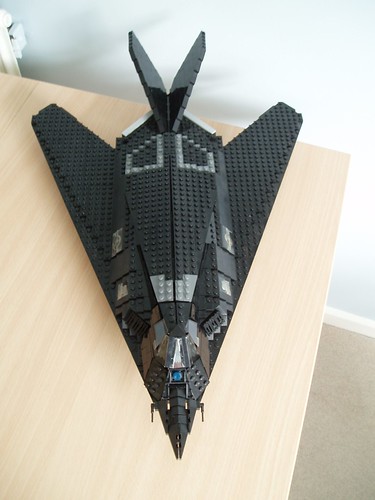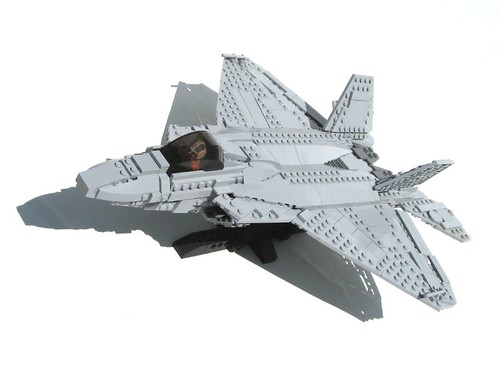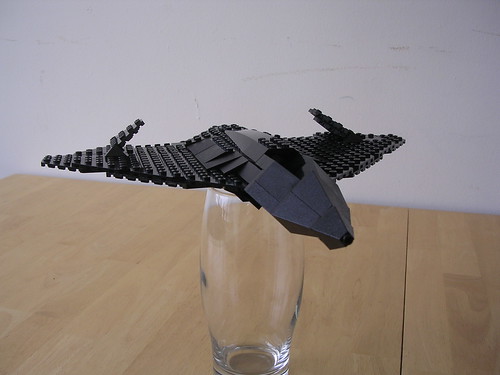A little mathematics
This is not your average blog post, because as a physicist and possibly a bit of a bore I now feel the need to introduce some mathematics -not because I want to scare the readers away, but because I do this sort of thing for fun and feel the mathematics are useful to illustrate the effect of stealth technology. The radar energy Iiper surface area that strikes the aircraft is inversely proportional to the square of the distance d from the transmitter.

Eo is the energy transmitted by the radar.
Similarly, the radar energy per surface area Ir that gets reflected back to the receiver is inversely proportional to the distance from the aircraft to the receiver squared multiplied by to the aircraft's Radar Cross-Section R and proportional to the aircraft's Radar Cross-Section R (typically given in m2). Combining this with the first equation gives:

The radar cross-section is what stealth is all about. It is a complicated function that depends on the shape of the aircraft and the direction from which it is seen, the material it is made of and the frequency of the radar and probably a few other things. Major contributors to the cross-section are the engine compressors and engine inlets, perpendicular surfaces on the airframe, edges such as the leading edges of the wings, externally carried weapons, and not surprisingly the aircraft's own radar antenna.
The last equation tells you the following: if the target aircraft is twice as far away, the energy that gets back to the radar is 24=16 times as small. In the real world the receiver will be picking up all kinds of radio waves, for instance background noise and reflections from birds or radar reflections from the ground. Signals processors and fancy computer algorithms can help to isolate the reflected waves from an aircraft from all this clutter, but there is a limit to Ir below which a reflection from an aircraft will not be detected. This limit obviously sets the maximum distance at which the radar can detect a target of a given radar cross-section. The last equation also shows that if a radar can only just detect an aircraft with a given value for R at, say, 100 km, reducing the value of R by a factor 10,000 (=104) will mean that the maximum detection range drops to only 10 km. While radar stations with a 200km spacing between them would be enough to detect an aircraft in the former case, an aircraft with a radar-cross-section that is 10,000 times lower can easily slip through the gaps.
Of course, a factor of 10,000 is a pretty big deal. The cross-section can be lowered using a combination of two different approaches. An aircraft (or ship) can be coated with purpose-designed materials or structures that absorb rather than reflect much of the radio waves that strike it. The aircraft can also be shaped such that radio waves that strike it are reflected away from the direction of the transmitter/receiver. Obviously, for building a LEGO stealth aircraft, this is the factor that matters.
The first stealthy aircraft
One of the first aircraft specifically designed with features to reduce the radar cross-section was the Lockheed SR-71 Blackbird, a high-flying reconnaissance aircraft used by the US Air Force from the 'sixties to the 'nineties. The leading edges of the wings incorporated structures designed to absorb radar. The wide 'chines' along the forward fuselage were there for aerodynamic reasons, but also decreased R.
The vertical tail fins were canted inward to prevent them from being perpendicular to the wing. The cones in the intakes were fitted for aerodynamic reasons as well, but also served to cover the engine compressors. Unfortunately all the efforts ultimately had little effect, however, because chemicals sprayed into the exhausts to prevent contrails from forming caused the massive wake of the aircraft to be visible to radar!
Full-blown stealth
Unlike the Blackbird, reducing the radar cross-section was of paramount importance in another aircraft designed by Lockheed, the F-117A Nighthawk. This was designed with one mission in mind: slipping undetected through enemy defences and bombing high-value targets with pin-point accuracy. The engines are buried deep inside the fuselage and the intakes are covered by grids (which appear as solid surfaces to radars). Because a radar antenna is a fantastic radar reflector, it didn't have one! The aircraft's shape was chosen such that most of the radar energy that strikes it is reflected in fairly narrow beams (spikes in the radar cross-section) away from the radar. Because computer programs at the time could not yet accurately predict how radio waves are reflected by curved surfaces, the shape was made up of a combination of flat areas, leading to a weird faceted look.
The aircraft was covered in special radar-absorbing coatings and its laser-guided weapons were carried internally. F-117As served with great success in the Gulf War of 1991, but by the end of the century the aircraft was showing its age and a single F-117 was shot down over Serbia in 1999, possibly because the aircraft flew more-or-less the same route for several days in a row and was actually spotted visually. All F-117s have now been retired.
Stealth, the next generation
At the time of the shoot-down, new and weird shapes were already flying. The USAF had taken delivery of 21 B-2 Spirit bombers (of which I have yet to see a decent LEGO version) and was developing its new air-combat fighter: the F-22 Raptor. The F-117s odd-ball shape seriously affected the aircraft's aerodynamic performance, but by the early 'nineties computer technology had finally caught up with the physics, and it was possible to build stealthy aircraft with smoother shapes and much higher performance.
The F-22 still has a number of features in common with the F-117. Large parts of the fuselage still consist of flat panels, but they now blend together more smoothly. Its intakes are not square (but trapezoidal), reducing reflections from perpendicular surfaces. The intake ducts are very long and curved, minimising returns from the engine compressors. While it can carry weapons externally, most of its weapons are carried in internal weapons bays. A final concession to stealthiness is something called 'planform alignment'. Since edges are large contributors to the radar cross-section, designers of stealth aircraft often align the leading and trailing edges of the wings with those of the tail planes and inlet lips. There will only be a spike in the radar cross-section in a direction perpendicular to the edge and since most of the edges line up there will only be a few spikes.
Reducing the cross-section by a factor of 10,000 comes at a price. The B-2 and the F-22 are the most expensive combat aircraft ever built, at roughly $2 billion and $200 million per aircraft, respectively.
Most nations cannot afford to design and operate aircraft that are this expensive and most modern European fighter aircraft (Eurofighter and Rafale), the American Super Hornet and also the PAK-FA currently under development in Russia are designed to have a reduced radar cross-section where it matters most: from the front.
There is much more to say about stealth technology. I've only talked about reducing visibility to radar for aircraft. Many modern ships have superstructures that avoid perpendicular surfaces to reduce their visibility to radar. An other important aspect for aircraft is their jet exhaust. It is much hotter than the surrounding air, which means it can be visible to Infra-Red detectors. The F-117 and the F-22 have rectangular engine exhausts instead of more normal round ones to allow the hot exhaust gasses to cool down more quickly.
If you were to chose to build a Stealth aircraft for the competition, there are a couple of things you might want to keep in mind:
- the engines ought to be buried deep inside the fuselage to hide their compressors
- planform alignment: leading and trailing edges are often parellel
- weapons are carried internally
- the shape often uses large flat surfaces
- you should avoid perpendicular surfaces, so tailfins, for instance, should be at an angle
Check out Magnus Lauglo's 'Black Arrow' to see an awesome example of a fictional stealth aircraft.
Happy building!





Ralph,
ReplyDeleteThanks for such a great introduction to the basics of stealth technology. And thanks for giving my little UAV a shout out too!
I'm beginning to understand that stealth is less about making something invisible per se to radar, as it is about reducing its signature to the point where it becomes close to indistinguishable from all the clutter that gets picked up and filtered out.
The planform alignment business was something I wasn't aware of, and I had to look it up on wikipedia to understand it fully - basically the use of paralell angles in leading and trailing edges of the tail and the wing, as well as intake ducts and the like. The fewer different angles in the airframe, the better (did I get that right?).
Has there been any successful of development of stealthy weapons or "stealth pods", which would allow weapons to be carried under the wings? I heard about this once, but have never seen any pictures of what these might look like.
Magnus
Thanks for your comment, Magnus.
ReplyDeleteYou pretty much got the idea behind planform alignment right. Whenever the radar is perpendicular to an edge, it'll pick up a stronger return. Aligning the edges on the airframe limits the number of angles under which a radar gets returns. An aircraft like the YF-23 took that concept further than the F-22, but even on the Super Hornet you can see how the upper and lower lips of the intakes have the same sweepback angle as the leading edge of the wing. The serrated edges on the landing gear doors (themselves a measure to reduce the return from the edge of the door) are also aligned at the same angles. The angles under which there are RCS spikes are actually included in mission planning for aircraft like the B-2, in order to route the aircraft such that the time at which enemy radars are perpendicular to the edges is minimised.
Semi-conformal carriage is one way to reduce the signature of externally carried weapons, but I too haven't seen any external weapons pods. Perhaps weapons that are themselves stealthy, such as JASSM, would not lead to a massive increase in RCS, but I can only speculate. An external gun pod is under development for JSF, but I don't remember having seen pictures of it yet.
so where do you buy this sets...i saw the stealth fighter a long time ago at kay bees toy store.
ReplyDeleteWhat I like from here is seeing all those aircrafts models because I have a collection at home so I'd like to get these ones in order to complete my collection.
ReplyDeleteJust for the record, none of these are for sale. There are some clone brands out there who may have produced sets of similar aircraft, but the models featured on this blog were designed and built by individual fans, not bought in a store.
ReplyDeleteLoved reading this thhank you
ReplyDelete